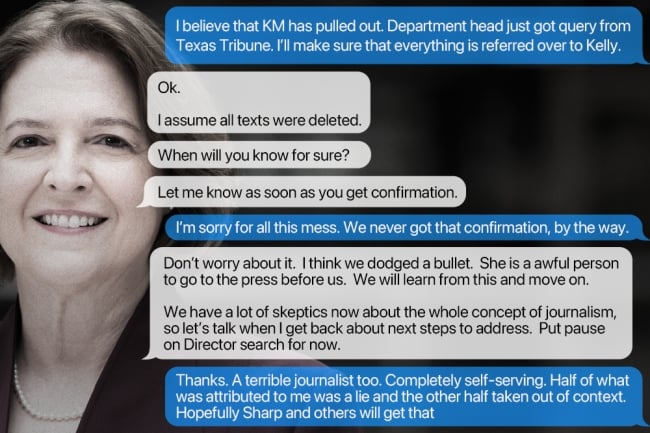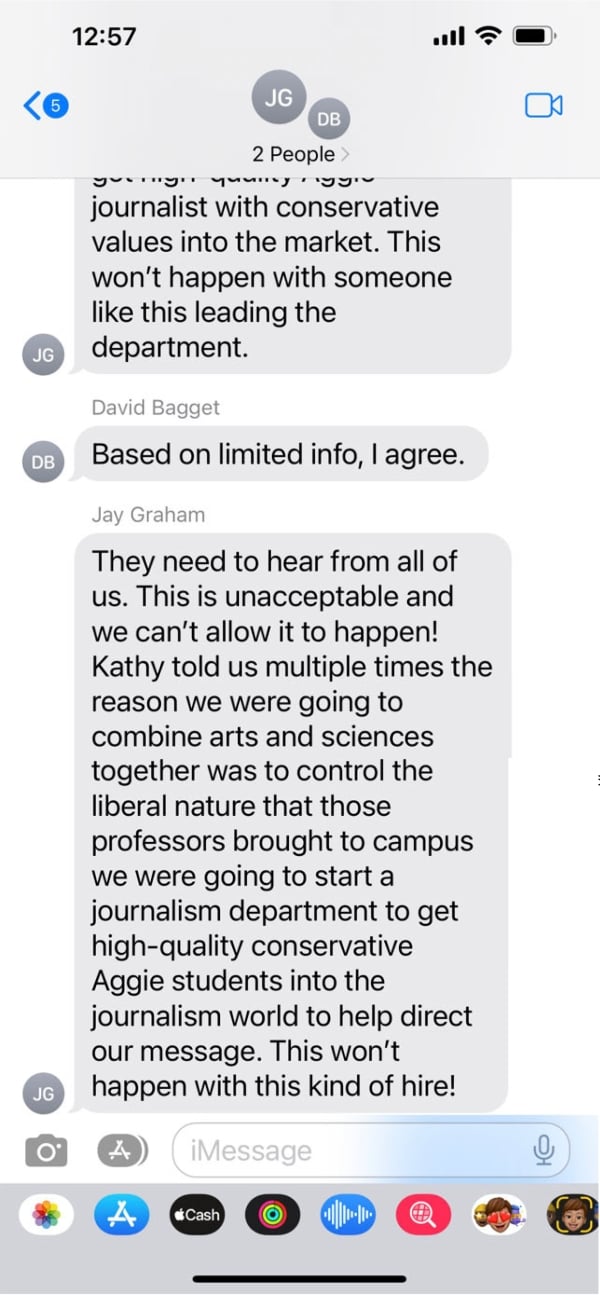You have /5 articles left.
Sign up for a free account or log in.

Documents released by Texas A&M, including text messages sent by Kathy Banks, confirm the president’s direct involvement in the Kathleen McElroy hiring controversy.
Photo illustration by Justin Morrison/Inside Higher Ed | Photo: Texas A&M University | Documents: Texas A&M University
Last month, as they sought details on what happened in a failed hiring effort, members of the Texas A&M University Faculty Senate suspected they weren’t getting the full story from top administrators.
President Kathy Banks pleaded ignorance in the hiring debacle surrounding Kathleen McElroy, telling faculty members she was unsure what led to McElroy’s claims that Texas A&M offered her a position—with tenure—in a newly formed journalism department only to change the terms of the deal due to concerns over her race (Black), her research and her past work at The New York Times.
Banks, over and over again, claimed to have no knowledge of a change in the contract. But by the time she left the online meeting, faculty members felt strongly the president wasn’t providing straight answers.
“We’re being lied to on a lot of fronts,” one professor said in the July 19 meeting.
“It cries out that we’re not being told a straight story,” another faculty member said.
A day later, on July 20, Banks retired abruptly, citing “negative press” over the hiring spectacle. She made no mention of the distrust expressed by faculty members or the pushback she had faced.
By July 21, the faculty’s concerns had been validated in a report from the Texas A&M system’s Office of the General Counsel that showed Banks’s direct involvement in the McElroy case, with the president’s fingerprints all over the decision to yank the offer and replace it with a nontenured option. The report spelled out, in clear facts, that Banks—under pressure from legislators and regents to drive Texas A&M in a conservative direction—was the architect of the failed hire.
(Banks did not respond to a request for comment from Inside Higher Ed.)
Even on its own, the dishonesty Banks displayed in the McElroy case would have likely sunk any presidency. But for Banks, the McElroy situation came two years into a contentious term, marked by clashes with professors and a top-down leadership style that eroded support from constituents across campus.
At the campus level, the story can be taken as one of hubris and dramatic missteps, but zooming out, the Banks tenure reflects the perils of the modern presidency amid increasing politicization of higher education, especially in red states where skepticism of academe is high.
Two Years of Tensions
Banks assumed the presidency in June 2021 after nine years at the helm of the engineering department. Banks had joined Texas A&M in 2012, coming over from Purdue University.
As dean of the College of Engineering at Texas A&M, Banks was celebrated.
“I must state that initially, when she was named president, I was very optimistic,” Raymundo Arróyave, a Texas A&M materials science and engineering professor, said by email. “In balance, despite the fact that I disagreed with some of the policies that she implemented as dean (this is usual, faculty do not agree with administration 100 percent of the time), I thought that she had been a transformational dean. Our college doubled in the number of students, faculty, footprint, etc. So, she was very effective at elevating the college and had similar hopes for the university.”
But, he added, “Dr. Banks quickly made it clear that her presidency was going to be [one] of dramatic changes. Many of those changes were poorly justified and poorly communicated (lack of effective communication was a common shortcoming of her tenure as dean, by the way).”
The first controversy of the Banks presidency began behind closed doors. Early in her presidency, Banks sought to establish her vision and introduce sweeping changes at Texas A&M. Those changes came in the form of recommendations from MGT Consulting in fall 2021 that included academic consolidation and reorganization, restructuring of certain administrative positions, and various programmatic changes.
But some with direct knowledge of those conversations suggest the recommendations from MGT Consulting were largely dictated by Banks. The president saw the recommendation process as a way to put forth her own ideas and let MGT Consulting take the heat when those proposals were met with resistance, said a source who served in the president’s cabinet.
“She said, ‘Our job is to tell them what we want to do, they’ll write it up in a report, and then, when there’s public criticism, we’ll say we’re following the advice of the consultants,’” the former cabinet member said, speaking anonymously due to concerns about career repercussions.
In conversations in the summer of 2021, senior leaders allegedly dictated to MGT Consulting the recommendations that the firm would later put forth as their own ideas, the source alleges.
“President Banks directly said, ‘Let’s put some things in there that we know the faculty will not like. And then we can reject them so it will look like we’re listening to them.’ The whole process was a PR sham to begin with,” the former cabinet member told Inside Higher Ed, noting that they were unsure of what poison pills were inserted since they did not work on faculty issues.
(MGT Consulting did not respond to a request for comment from Inside Higher Ed.)
Blowback to the MGT Consulting recommendations was immediate. Faculty raised concerns about combining the College of Liberal Arts, the College of Science and the College of Geosciences into a new College of Arts and Sciences. While the university offered little public rationale for the change, recent public documents released by Texas A&M related to the McElroy scandal indicate that—according to a text message from Jay Graham, a member of the Board of Regents—Banks had said the academic consolidation was “to control the liberal nature that those professors brought to campus.” (Neither Graham nor system officials responded to questions about that claim.)

Text messages show regents attempting to influence the hiring and direction of Texas A&M's journalism school.
Texas A&M University
Plans to eliminate tenure for librarians also prompted objections from faculty, particularly as administrators refused to explain the rationale for months before eventually making the argument that a reorganization of the library was needed to streamline and simplify operations to emphasize student needs. Despite the objections of faculty, nearly 30 librarians lost tenure or tenure-track status last year. Others decamped to different departments to maintain tenure.
Outside of the controversy generated by the MGT Consulting report, Banks also stirred anger on campus by announcing plans to kill the print edition of the student newspaper in February 2022 before backing away from that decision. Two months later, Banks defunded Draggieland, an annual drag show run by student organizations in partnership with the university. That decision, made with no initial explanation, prompted outcry from students and LGBTQ+ organizers. Officials would later assert that Draggieland was self-supporting due to ticket sales.
Last July brought changes to Texas A&M Qatar, an overseas outpost operated in conjunction with the Gulf nation’s government. Texas A&M reorganized the Qatar campus, eliminating rolling contracts for faculty in favor of fixed-term deals while consolidating power under one dean and limiting research activities for professors in non-degree-granting units, as outlined in a Banks memo.
Faculty members decried the top-down decision-making, arguing that the elimination of rolling contracts would undercut recruiting efforts and academic freedom at A&M Qatar. As these changes played out, faculty members on the main campus accused Banks of ignoring shared governance and leaving them out of important decisions as she pursued her own agenda.
A Faculty Senate resolution last August accused Banks of a “lack of commitment to meaningful shared governance” that was “promulgating a mistrust of future administrative decisions.” The “absence of shared governance” was “exacerbated by a lack of transparency,” the resolution stated.
As discontent with Banks continued, Karen Wooley, a distinguished professor in the department of chemistry, wrote a letter to Banks in December accusing her of “causing substantial disruptions and threatening the integrity” of Texas A&M, according to various media reports.
In January, Banks announced efforts to increase communication and provide more face time for faculty and staff with university administrators as well as the formation of two new committees to “improve our continuous evaluation and feedback” led by senior administrators, among other changes.
But the January olive branch from Banks did little to settle faculty concerns. By April of this year, frustration with the president’s top-down management style had reached a boiling point. A poll of members of the Council of Principal Investigators, a group of faculty members who help guide research efforts at Texas A&M, found “widespread discontent” and alleged that administrators had created an environment rife with fear and intimidation, The Texas Tribune reported. The poll, inspired by Wooley’s letter, found 89 percent of CPI members had similar concerns.
A Faculty Senate Showdown
By the time Banks met with the Faculty Senate on July 19, tensions on campus were high. The story of how McElroy’s hiring fell through was opaque at the time, and the faculty wanted answers. Instead, Banks deflected their concerns, downplaying her role in and knowledge of the hiring debacle.
Arróyave, the materials science professor, pressed Banks with hard questions, later telling Inside Higher Ed that there was “too much confusion as to who wrote the offer letters, who modified them, who was aware of the additional contract negotiations, etc.” Based on his experience with Banks as engineering dean, Arróyave said he “found it difficult to believe that she was not aware of the contract negotiations.”
The distrust of Banks by faculty members in the meeting was palpable.
Concerns swirled about the influence of outside organizations such as the Rudder Association, a powerful conservative alumni group, and others who were celebrating the failed hire. What faculty didn’t know at the time was that Banks had worked with José Luis Bermúdez, interim dean of the College of Arts and Sciences, to restructure McElroy’s offer. Bermúdez—who resigned amid the scandal—schemed with Banks on the plan to change the role McElroy was stepping into, as demonstrated in documents later released by the Texas A&M system.
Emails and text messages between university officials, including Banks, indicate that McElroy’s past as a Black woman who worked for The New York Times and researched diversity, equity and inclusion issues was a potential headache for Texas A&M. Banks stressed that it was important to slow-walk the hire until after the end of the legislative session in May, and Bermúdez told a subordinate that it would be “poor optics” to hire McElroy with DEI under fire in Texas. (Lawmakers implemented sweeping restrictions on college DEI offices and work last session.)
As administrators deliberately delayed the process, McElroy dropped out of the running.
“I believe that KM has pulled out. Department just got query from Texas Tribune. I’ll make sure that everything is referred over to Kelly,” Bermúdez texted Banks on July 10, seemingly referring to Kelly Brown, associate vice president of marketing and communications at A&M.
In the exchange that followed, Banks would go on to call McElroy an “awful person” for going to the press and noted, “we have a lot of skeptics about the whole concept of journalism,” while directing Bermúdez to pause the search for a director of the nascent program.
Text messages between regents, released as part of Texas A&M’s internal review, demonstrated that board members also seemed to be exerting influence over the departmental hiring decision.
“Please tell me this isn’t true,” Graham texted Banks and system chancellor John Sharp about plans to hire McElroy. “But since it’s not April Fools Day, I assume it is. I thought the purpose of us starting a journalism program was to get high-quality Aggie journalist[s] with conservative values into the market. This won’t happen with someone like this leading the department.”
Another regent, Mike Hernandez, questioned McElroy’s résumé—calling The New York Times “biased and progressive leaning” and suggested tenure approval would be “a difficult sell.”
(Neither Graham nor Hernandez replied to requests for comment.)
Texas A&M would soon settle with McElroy for $1 million. (McElroy, who remains in her position as a journalism professor at the University of Texas at Austin, did not respond to a request for comment.)
Outside Influence in Texas
The McElroy hiring controversy has since been followed by another scandal at Texas A&M in which opioid researcher Joy Alonzo was suspended by system officials and investigated for comments she allegedly made about Lieutenant Governor Dan Patrick, a powerful figure in Texas.
The investigation ultimately cleared Alonzo of wrongdoing, and system officials claim that all policies were followed appropriately. But the two controversies combined have raised lingering questions about the political influence exerted on Texas A&M by state lawmakers and others.
A spokesperson for the flagship campus largely deferred questions to system officials but emphasized, in response to an inquiry about outside political influence, that “Texas A&M prioritizes maintaining an environment that encourages academic freedom, critical thinking and intellectual diversity.”
A Texas A&M system spokesperson did not answer a list of detailed questions from Inside Higher Ed, instead sending a link to a news release summarizing the recent legislative session. Pressed for answers, system spokesperson Laylan Copelin deferred questions to the university.
In a recent editorial, however, Sharp discussed the dual scandals with McElroy and Alonzo.
“Regarding the events in Dr. McElroy’s hiring process, it is difficult to recognize the alma mater I dearly love and to which I owe so much. Texas A&M is far better than this!” Sharp wrote in an opinion piece for The Austin-American Statesman. “A few, however, forgot our Core Values.”
Sharp touched lightly on academic freedom concerns, defending his actions in the Alonzo controversy, and pointed to legislation to codify tenure in state law—after it came under attack from legislators—which he noted was a win for both “academic freedom and accountability.”
But some faculty members worry less about outside influence and more about what direction a politicized Board of Regents and university officials want to take the university and system.
“This is not outside influence. It is clear that (at least some of) the maximum authorities of the system would prefer a more conservative disposition by the faculty and university. Frankly, I think it is highly contradictory to denounce identity politics and then call for the production of ‘conservative journalists’ out of the new journalism school,” Arróyave said, noting broad concerns about the worrisome “interference of politics and ideology into academia.”
Since both the Alonzo and McElroy controversies, university and system officials have stressed the importance of academic freedom and resistance to outside influence on the institution. But as recent documents made clear, the pressure isn’t just from Texas lawmakers—it is also coming from the inside, with regents appointed by Republican governor Greg Abbott, many of whom donated generously to his campaign, intent on pushing Texas A&M in a conservative direction.








